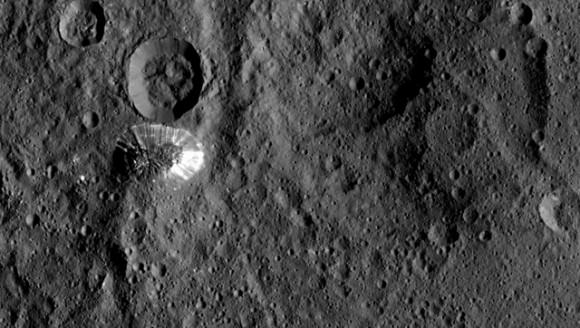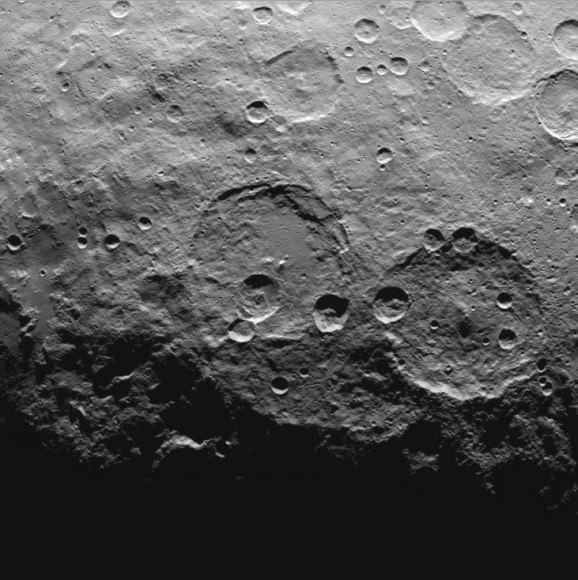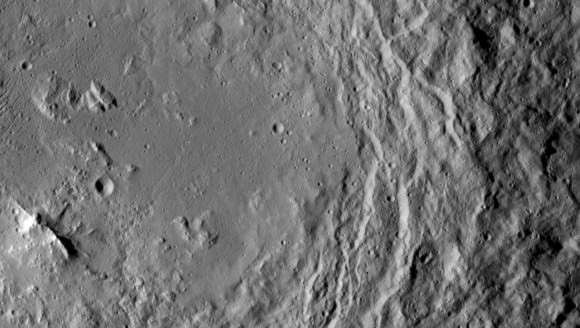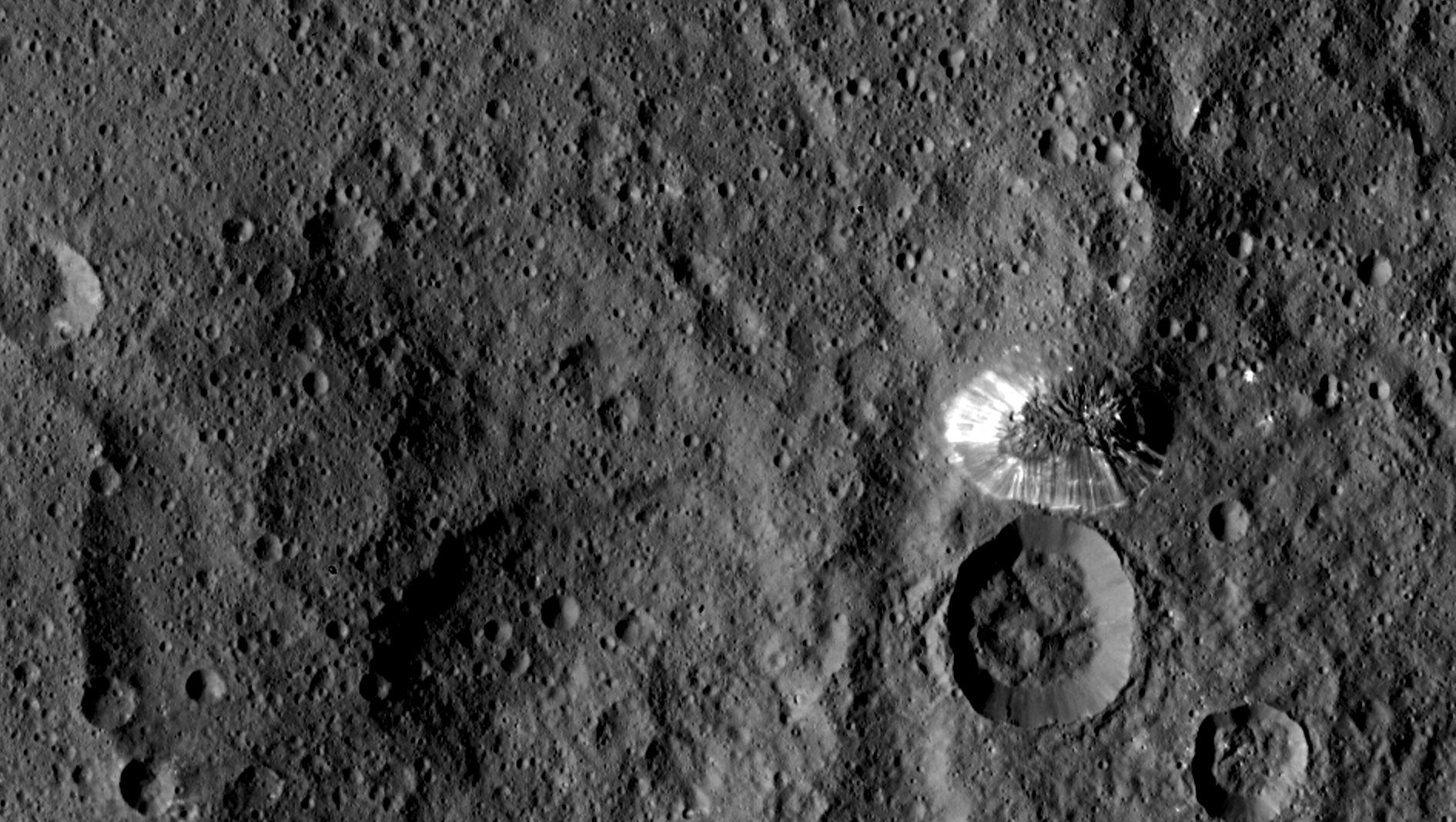The Dawn spacecraft is now orbiting just 1,470 kilometers (915 miles) above Ceres’ surface, and the science team released these latest images. Above is a closest view yet of the so-called ‘pyramid’ on Ceres, although the closer Dawn gets, the less this feature looks like a pyramid. It’s actually more like a conical mountain with a flat top, almost like a butte.
And if you’re like me and you see a crater instead of a mountain, just turn the picture over (or stand on your head). Below, we’ve turned the image upside down for you:

The mountain is located in the southern hemisphere, and stands 6 kilometers (4 miles) high. Visible on the sides of the mountain are narrow braided fractures and an intriguing bright area. Only time will tell if this bright region is similar to the mysterious bright spots seen in previous Dawn images of Ceres. The team released additional images as well.

As Dawn slowly moves ever-closer to Ceres surface, the team says the spacecraft is performing well.
“Dawn is performing flawlessly in this new orbit as it conducts its ambitious exploration. The spacecraft’s view is now three times as sharp as in its previous mapping orbit, revealing exciting new details of this intriguing dwarf planet,” said Marc Rayman, Dawn’s chief engineer and mission director, based at NASA’s Jet Propulsion Laboratory, Pasadena,
Dawn is currently taking images to try and map the entire surface. This will 11 days at this altitude and each 11-day cycle consists of 14 orbits. Over the next two months, the spacecraft will map the entirety of Ceres six times.

Using Dawn’s framing camera to map the surface in detail, scientists hope to create a 3-D modeling of Ceres’ surface. Every image from this orbit has a resolution of 450 feet (140 meters) per pixel, and covers less than 1 percent of the surface of Ceres.
At the same time, Dawn’s visible and infrared mapping spectrometer is collecting data that will give scientists a better understanding of the minerals found on Ceres’ surface.
The science and engineering teams are also taking a look at the data coming in from radio signals to help with measurements of Ceres’ gravity field. This will help determine the distribution of mass on Ceres interior and might provide clues if the asteroid has any liquid water beneath its surface.
Additionally, the radio data data will help mission planners design the maneuvers for lowering Dawn’s orbit even more. In late October, Dawn will begin spiraling toward this final orbit, which will be at an altitude of 375 kilometers (230 miles.)
In the latest entry on the Dawn Journal, Rayman said despite the loss of the reaction wheels (in 2010 and 2012) that help maneuver the spacecraft and keep it stable, engineers have learned how to be very efficient with the precious hydrazine the fuels the small jets of the reaction control system and they now have some to spare. They now expect to exceed the original mission parameters!
“Therefore, mission planners have recently decided to spend a few more in this mapping orbit,” Rayman said. “They have added extra turns to allow the robot to communicate with Earth during more of the transits over the nightside than they had previously budgeted. This means Dawn can send the contents of its computer memory to Earth more often and therefore have space to collect and store even more data than originally planned. An 11-day mapping cycle is going to be marvelously productive.”
There’s still a debate about the unusually bright spots in some of Ceres craters that appear when the asteroid/dwarf planet turns into the sunlight. The team has speculated that they could be frozen pools of water ice, or patches of light-colored, salt-rich material.
The brightest spots are known collectively as Spot 5, and sit inside Occator Crater on Ceres, and hopefully new images of this area will be released soon. In a previous article on Universe Today, Dawn’s principal investigator, Chris Russell of the University of California at Los Angeles told us that the debate is continuing among the science team, but he wouldn’t harbor a guess as to which way the debate might end or which “side” was in the lead among the scientists.
“I originally was an advocate of ice, because of how bright the spots seemed to be,” Russell told writer Alan Boyle, but newer observations revealed the bright material’s albedo, or reflectivity factor, is about 50 percent – which is less than Russell originally thought. “This could be salt and is unlikely to be ice. I think the team opinion is now more in line with salt,” he said.
You can cast your vote as to what you think the bright spots are at this NASA page.
See all the latest images from Dawn at JPL’s Photojournal page.


Thank you for the update, Nancy!
But where are the alien landing conspirators? The flat-topped mountain is a natural landing spot. They would want to utilize the view, wouldn’t they?
(Does anyone have an estimate of the gravity of Ceres? What would my 170 pounds be like there?)
Wiki says that the surface gravity on Ceres is only 3% of that on Earth. 170 pounds would be like 5 pounds there. Maybe aggressive weight loss marketing is what will finance human space flight?
This would appear to be along the lines of electric universe stuff and not alien-stuff.
Pete, with lots of fantasy you could …
Imagine the smooth, shiny side of the mountain to be a partial buried spaceship where the hull got wrinkled as it soft_crashed into the ground. Mind you, the mass of the ship generates a lot of energy, even if the speed was well below the 1 km/s.
The original topsoil still sits on top of the spaceship as it shoved nose first into the ground at an angle of -30 degrees. with the right side slightly higher than the left side.
The wrinkles can be seen to radiate from a central point, the top of the spaceship, which got the brunt of the force while the soil/rigolith got pushed up.
There is also a secondary central point for the wrinkles, more to the back of the spaceship … as if the back of the ship slided sideways, and thus slightly sliding up.
If you look close enough, you might even imagine to see part of the hull been pulled back at the front of the spaceship, showing part of the interior, with struts and beams visible.
Hope this story helps to see the aliens … with a cith of light in a crater, no doubt for the obvious reason of a water source underground…
Cheers
😀
How disappointing no new white spot images that we all want to look at come on NASA stop hiding this info release these images and dont air brush out the details…
NASA isn’t hiding anything; you are paranoid delusional, like all the bozos who believe that NASA is involved in some kind of conspiracy. There’s a place for people like you, and it isn’t on this website, which is devoted to science.
robst247 you are a pea brained idiot that is not even allowed to clean my boots have you worked with NASA (NO) have I (YES) people like you will always live with blinkers on I have forgotten more about Science than you will ever learn.
Dick
Whassup over thar… Mom? Usually you are more informative oriented, with good links an stuff. You know how things are on the i-net.. It’s always catch as catch can. As in… sometimes we find diamonds and jewels, and sometimes we don’t. Still… I for one, haven’t stopped fishing!
Well then UFO’sSister, I guess your Boots are staying Dirty.
If you give it you had better be able to take it lol
The more I look at that hill, the weirder it gets. The flat bit at the top looks old and almost like the surrounding ground, but the scree slopes all the way around look new. If it is made out of the same stuff as the sides of the nearby crater, then you might expect the stuff to have the same colour and support the same maximum slope, but it does not look like either is the case.
Giant Space Barnacles. That’s all I’ve got.
Sounds good to me. One side seems to blend into the surroundings while the other stands sharply different.
I could convince myself it is semi-volcanic in that there might be a dimple of a crater right middle of the flat top from which material could flow (salt-water ice flow?) along cracks (rill?) at least one of which ends in a raised structure down the side of the mountain and seems to start thin and spread out slightly going down hill.
But the odd thing is the way craters at the very edge seem to stretch upwards along the sides which seem to imply raising up and stretching things rather than stuff going down hill and covering things.
This is a common illusion for many people, because depending on the angle of the Sun when the picture was taken, images of craters taken from overhead (i.e. from orbit) may appear to be a mountain. Turning the image upside down corrects the illusion but not always! We wrote an article about this illusion and why it happens here: http://www.universetoday.com/118616/do-you-see-a-mountain-or-a-crater-in-this-picture/
This mountain is seriously interesting. How could it have possibly been formed? I’ve seen dozens if not hundreds of ideas here and elsewhere on the web. Some are frankly entirely fanciful, while others make sense but lack associated evidence(s). I zoomed in on the lead image and took a closer look. I noticed after studying the image for a while that there are certain features at the bottom of the crater which are apparently .. get this .. mirrored on the top of the cone shaped moutain! There is a depression that fits then there is also a spiral pattern that fits if twisted CCW 55*, then inverted. A very strange couple of coincidences…
HOW could this happen? A mountain sized cone blown upward, flipped then rotated and landing in one piece’? That would be just too weird.. then again.. what is Ceres escape velocity? WHAT cause? An antipodal impact remnant? Or maybe a cryogenic geyser or even a ‘natural’ nuclear explosion from below? A mini black hole passage? NOW I’m getting ‘out there’… Thanks UT
Escape velocity of Ceres is ~515 m/s.
the impact crater caused a depression of a rocky plate, creating a high pressure volume underneath
The pressure vented through the vulcano style mountain.
Most probably gasses and some liquids spilled from the one time pressure vent “vulcano”.
And will over time be leveled slowly with every Ceres quake.
Ceres, being a small and relatively low mass object, likely cooled quickly enough to prevent any large scale differentiation from core to crust so the interior would be less homogeneous than a larger body.
If there were a large pocket of ice underground that was melted by an impact, perhaps the conical mountain is a giant frost-heave produced when the ice refroze. It seems unlikely but it could explain the coloration and there is an impact crater right next to it.
As for the bright spots possibly being salt, I’ve never heard mention of high concentrations of salt in space. What would be the mechanism(s) behind producing a salt asteroid or high concentrations of salt on an asteroid?
Why do the bright spots remain a mystery? No one bothering to get a better look at them? NASA afraid of what they will eventually find? Or do they already know and don’t want to publish the images because they are too shocking for the general audience? Cover up – cover up…..